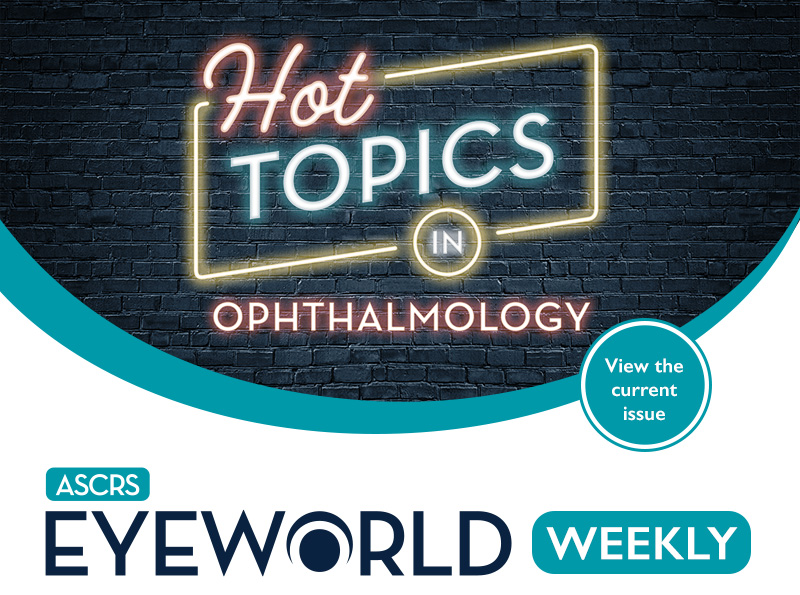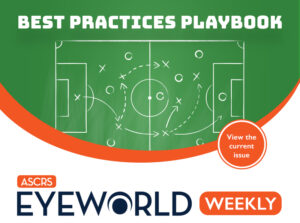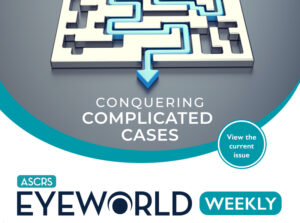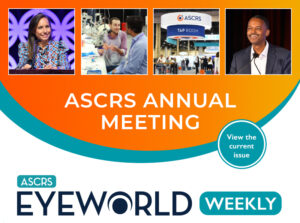
- Positive preclinical results for non-viral gene therapy platform
- Real-world data confirms efficacy of investigational LHON therapy
- Largest genome wide study of photoreceptor cells to date
- CDC continues to investigate infectious outbreak associated with artificial tear use
- Updates from AAV-based gene therapy program for retinal conditions
- ASCRS news and events
March 17, 2023 • Volume 29, Number 11
Positive preclinical results for non-viral gene therapy platform
Intergalactic Therapeutics announced positive preclinical results for its subretinal administration of IG-002, a non-viral gene therapy for ABCA4-related retinopathies. The company’s press release reported that a single administration of this gene therapy resulted in 12-month expression of the human ABCA4 protein in porcine retinas. The DNA was delivered to its target location using the company’s proprietary delivery system and its covalently closed circular DNA cargo platform, which according to the company is designed to overcome the limitations that can be associated with AAV gene therapies. ABCA4-related retinopathies include Stargardt disease, cone-rod dystrophy, and retinitis pigmentosa.
Real-world data confirms efficacy of investigational LHON therapy
GenSight Biologics announced real-world efficacy and safety data from patients who have ND4-Leber hereditary optic neuropathy who were treated with lenadogene nolparvovec (LUMEVOQ) as part of an early access program. The real-world data, which was collected from the U.S., France, Italy, and the U.K., showed that the intravitreal injections increased mean change in BCVA at 1 year post-treatment by 22.5 ETDRS letters, according to the company’s press release. The results are consistent with those observed in clinical trials. Sixty-four percent of eyes achieved improvement of at least 15 ETDRS letters, and 60% achieved clinically relevant recovery. In a separate press release about its Phase 3 clinical trial, the company reported sustained efficacy and safety observed 3 years after injection.
Largest genome wide study of photoreceptor cells to date
Researchers at the European Molecular Biology Laboratory, using image and genomic data from the UK Biobank, have performed what they called the largest genome-wide study of photoreceptor cells. According to a news article from the laboratory, this analysis provides insights into rare ocular diseases, including retinal dystrophies, and avenues for future research. According to the news article, some genetic variants in the study associated with eye diseases were known, while other genetic variants were near genes that the article stated were “known to cause rare genetic eye diseases when disrupted.” The study is published in the journal PLOS Genetics.
CDC continues to investigate infectious outbreak associated with artificial tear use
Earlier this year, the CDC and the FDA issued warnings for patients to stop using preservative-free EzriCare and Delsam Pharma’s artificial tear products due to an outbreak of drug-resistant Pseudomonas aeruginosa, which has been associated with different types of infections, including ocular. This strain, according to a news article from the NEI, was not previously reported in the U.S. The CDC continues its investigation, and physicians in the NEI article advocate that providers who see patients with vision-threatening infections be “especially vigilant about identifying the causative pathogen.”
Updates from AAV-based gene therapy program for retinal conditions
Abeona Therapeutics announced three investigational gene therapy product candidates for Stargardt disease (ABO-504), X-linked retinoschisis (ABO-503), and autosomal dominant optic atrophy (ABO-505). According to the company’s press release, these product candidates are based on Abeona’s AAV-based therapies that use novel AAV capsids.
ASCRS news and events
- ASCRS Annual Meeting: Registration for the ASCRS Annual Meeting, May 5–8, 2023, in San Diego, California, is ongoing. Review the ASCRS ASOA Real-Time Program for the latest program details.
- Eyecelerator: Registration is open for Eyecelerator @ ASCRS 2023. The innovation conference from ASCRS and the American Academy of Ophthalmology will be held on May 4 in San Diego, California. Join investors, industry leaders, and ophthalmologists at this showcase of companies, technology, and other exciting innovation topics in ophthalmology.
Research highlights
- A randomized, masked, placebo-controlled, prospective pilot study that evaluated the safety and efficacy of processed amniotic fluid drops used after PRK was published in the Journal of Cataract & Refractive Surgery. The study included 61 patients who received either placebo or the processed amniotic fluid drops, each instilled 4 times per day for 1 week after PRK with other postop medications. According to the paper, there was not a significant difference in re-epithelialization time (median 5 days in both groups). There were also no differences in pain scores and corneal staining scores between the two groups. There were no treatment-related adverse events.
- A study published in the journal Clinical Ophthalmology analyzed visual outcomes and accuracy of IOL calculation formulas in predicting postop outcomes in patients who had flanged intrascleral IOL fixation with the double-needle technique. The retrospective chart review included 23 patients who had this secondary IOL placement. Visual acuity improved from 20/577 to 20/58 postop. According to the paper, Holladay 2, SRK/T, and Barrett Universal II yielded a mild myopic surprise (–0.55 D, −0.18 D, and −0.20 D, respectively), while the Haigis and Hill-RBF yielded a mild hyperopic surprise (+0.28 D and +0.28 D, respectively). The study reported that the Hoffer Q and Holladay 1 formulas were the most accurate (−0.02 D and −0.08 D, respectively). The authors also stated that effective lens positioning after intrascleral haptic fixation is “likely similar to in-the-bag positioning.”
Product news
- IHEEZO (chloroprocaine hydrochloride ophthalmic gel, Harrow) received transitional pass-through status from CMS, making it reimbursable in all traditional settings of patient care. The ocular surface anesthetic also has a J-code for in-office use.
- Sight Sciences launched the Ergo-Series of the OMNI Surgical System, which features new handle ergonomics, a new cannula tip design, and a detachable viscoelastic luer connector.
This issue of EyeWorld Weekly was edited by Stacy Jablonski, Liz Hillman, and Ellen Stodola.
EyeWorld Weekly (ISSN 1089-0319), a digital publication of the American Society of Cataract and Refractive Surgery (ASCRS), is published every Friday, distributed by email, and posted live on Friday.
Medical Editors: Sumit “Sam” Garg, MD, Chief Medical Editor, Mitchell Weikert, MD, Cataract Editor, Karolinne Rocha, MD, PhD, Refractive Editor, Julie Schallhorn, MD, Cornea Editor, Manjool Shah, MD, Glaucoma Editor
For sponsorship opportunities or membership information, contact: ASCRS • 12587 Fair Lakes Circle • Suite 348 • Fairfax, VA 22033 • Phone: 703-591-2220 • Fax: 703-591-0614 • Email: ascrs@ascrs.org
Mention of products or services in EyeWorld Weekly does not constitute an endorsement by ASCRS.
Click here to view our Legal Notice.
Copyright 2023, EyeWorld News Service. All rights reserved.



